A Culinary Tour of Rioja, Spain
Articles and Photos by Beebe Bahrami
7/2008 with resources updated 12/12/2023
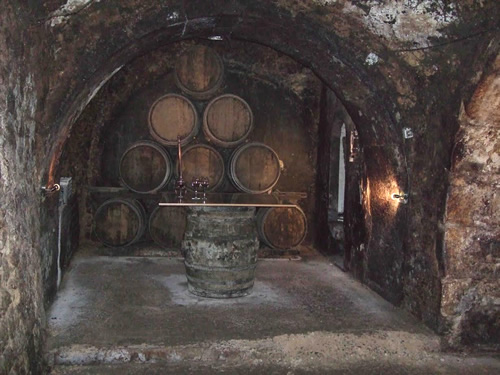
|
|
Wine cavern in Bodegas Carlos San Pedro, Laguardia.
|
Rioja. Say the name, and people will immediately think of Spain's most famous wines. But Rioja is also a fascinating little autonomous province filled with not only great expanses of sweeping and rolling vineyards but also fascinating monasteries, legends of hermits, knights, queens, and kings, and a mixed world caught between, blending the best of the neighboring Navarrese, French, Basques, and Castilians. Rioja is also a land of ancient dolmens built by Spain's first agriculturalists around 4,500 years ago and pockets of some of Spain's most enchanting forests, rife with wild mushrooms and game. Then, the favorite Riojan activity of making and drinking wine pairs perfectly with the region's culinary bounty.
While beautiful churches and miracle-working saints dot the region, Bacchus, the great classical god of wine, lives in the soil. Winemakers work closely with him to ensure an elixir worthy of the Riojan denomination. Everywhere you go, you can find some sign of Bacchus, subtle or bold.
Here is how to explore Rioja's vast offerings of historic sites, great foods, and wines. I worked this out for myself, as everyone recognizes the province's wine but knows little else about the area. Rioja is an area that offers travel for pleasure at Provencal or Tuscan standards. Riojans take great joy in their food and wine, from its growth and production to its preparation and consumption. I found my time in Rioja as enchanting as the time I spent in Provence and among the most perfect blending of hiking, eating, and drinking to be found anywhere in Spain or Europe.
I focus on four manageable and complementary areas in Rioja. Such areas together make for an excellent total experience that can be done in a week or drawn out and savored over a longer time without losing its dynamic appeal. These are the food and wine scene in Logroño, Rioja's capital; wine touring and dolmen hiking in and around the wine town of Laguardia; a visit to Haro, Rioja's principal wine capital; and the two Riojan monasteries of Yuso and Suso, which stand near each other in wine country and serve as an uplifting spiritual retreat.
Suso and Yuso are in what is known as the Rioja Alta, as is Haro. Laguardia is a part of the Rioja Alavesa wine region. Logroño, and if you wanted to include more, Calahorra, to the southeast, is in the Rioja Baja region. These viticultural designations demarcate three growing areas within Rioja with different soils, microclimates, and geographies. The Rioja Alavesa is governmentally a part of Basque Country, but wine-wise, it is 100 percent Riojan.
Logroño — Food Market, Tapas, and St. Bartholomew’s Church
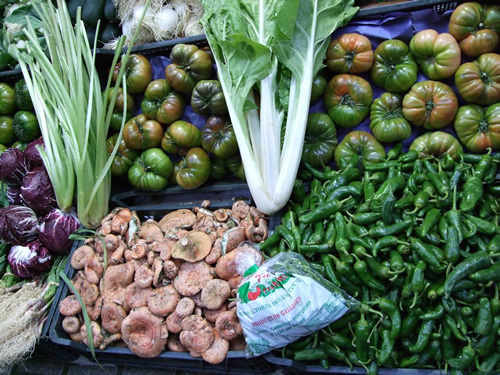
|
|
Logroño's fresh vegetables at the market.
|
Logroño is a great first stop. It can serve as a home base since, in this small region, everywhere is accessible from the capital.
Logroño, like nearly all serious wine towns and cities in Rioja, sits on the banks of the Ebro River. Though most of its medieval character has been whittled down to a small historic center, it is charming and filled with culinary delights that keep visitors occupied for a few days. Here, you will find Logroño's central covered market, Mercado de Abastos, reached from Calle del Peso. Abastos is a great place to see all of what the region produces seasonally: Heaps of greens, including herbs and grassy sprouts, still with roots and soil, to be used at their freshest in salads and soups. The vegetables are jewel-toned, the favored slim, long red pepper stealing the show. But then quickly competing are curly escarole and artichoke globes on their leafy stalks or the many varieties of mushrooms. Next are the cheeses and sausages from local, domestic, and wild animals. The ubiquitous wine seller sells gallon-sized jars of dried wild mushrooms and wreaths of garlic and dried red peppers.
Just around the corner, on Calle Laurel and perpendicular to Laurel on Travesía del Laurel, is an array of tapa places and restaurants. The best time for tapas is late morning when all the tapa places seem to open up for the locals until they reach their mid-afternoon lunch hour. Some of Spain's freshest and most creative tapa-making occurs on these streets. Often, a place specializes in one tapa and does it really well. You should wander around, order a glass of wine, and sample each. One place specializes in herb-grilled scallops, another in grilled mushrooms and shrimp, and another makes only paprika-marinated pork kabobs set on the grill when you order them. As you go through the tapas, keep your eye open for the restaurants interspersed between the tapa joints, with their daily menus posted outside.
While in Logroño's historic quarter, there is an exciting medieval church worth visiting, St. Bartholomew. This 12th-century church is used by locals as a spiritual respite from the busy world outside. It is a delightful medieval church spared the excessive ornamentation of later Baroque altars. It retains simple stone sculptures and has shallow stone niches rather than those gold embossed overly ornate side chapels of other places that can often distract from a more directed spiritual focus of meditation.
Laguardia — Wine Caverns, Medieval Churches, and Bronze Age Dolmens
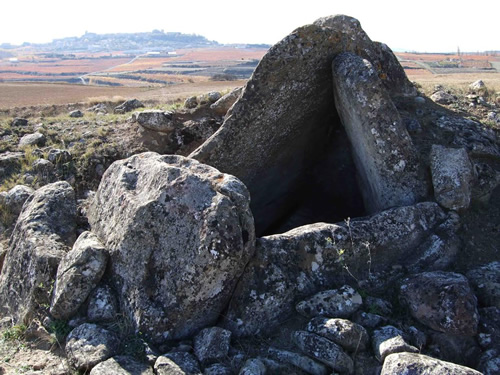
|
|
One of the many dolmen in the Laguardia region.
|
At one of the medieval stone gates to Laguardia, the Puerta de San Juan bears a tile plaque that reads, "Paz a los que llegan, Salud a los que habitan, Felicidad a los que marchan," ("Peace to those who arrive, Health to those who live here, and Happiness to those who depart"). This sentiment describes the joy of being in Laguardia, a perfectly preserved medieval wine town whose people are unspoiled by their treasure, keeping it as it was and not allowing artifice and gaudy tourism to overtake it. This is one of Europe's medieval gems.
In the church, Iglesia de Santa María de los Reyes, the 12th to 15th-century Gothic portal was restored and then protected by a 17th-century Baroque façade that was built over it. It is a unique chance to see what these magnificent portals looked like initially. Nowhere else in Spain and perhaps Europe will you find a stone-carved medieval portal with its polychrome painting still intact.
Laguardia is also unusual for its cavernous, manufactured subterranean world below its streets, once underground passageways for escape during times of war. They were turned into ideal places to make wine. But today, cars, carts, and even donkeys are prohibited in town. There are over 230 caverns. These caverns have the ideal temperature and humidity for winemaking. Still, because the grape harvest must be carried in on people's backs, only two bodegas continue to make wine here today. Beyond the medieval walls, around the town's hill below, are dozens of wineries making traditionally crafted wines in more modern facilities.
In this same region, several stunning Dolmen sites to which the excellent tourist office in Laguardia can orient you. Current estimates are that the area has some 85 dolmens, with 7 striking and worth visiting. The dolmens, dating between 4,000 and 2,500 years ago, are indications that early agriculturalists in Iberia also saw the potential of Riojan terroir. As usual, the dolmens are set in places with exquisite vistas to give the deceased buried in them a tremendous eternal view. They are also likely sites of ancient rituals, so the sacred placement was also for the living. Hiking out to a dolmen and back through the vineyards is a great way to work up an appetite, not to mention a thirst.
Haro — Harvest Mary, Wineries, Tapas, and Wine Museums
If you arrive in Haro by bus, the station is just around the corner from the Basilica de Santa Maria de la Vega, Our Lady of the Fertile Plain. On the altar sits a carved statue of the Virgin Mary holding stalks of wheat. This church reinforces what is to be found everywhere in Spain — that the Cult of Mary is more primal and symbolic than any other form of reverence, with its deep roots in an ancient matriarchal past in Iberia. It also expresses the respect for women in Spain, which I feel each time I visit. (I have been seeing, living in, and traveling about Spain since 1986.)
Haro is the heart center of the Rioja Alta region, with many wineries. On approaching Haro from Logroño, you will pass the Dinastia Vivanco wine museum and its gardens dedicated to Bacchus in the village of Briones. While advance reservations are required here, if you continue to Haro, the wine museum and learning center are open to drop-in visitors during the week.
Going deeper into the medieval center of old Haro, tapa restaurants proliferate and offer creative and delicious food made to order with your Crianza, Reserva, or Gran Reserva. My favorite places here are Restaurante Beethoven I and II, two establishments across the street from each other that offer excellent Riojan cuisine. Beethoven II, popular with locals, offers delicious tapas. Sometimes, it has a wine-and-mushroom-inspired tasting menu: My recent visit there was in the autumn, and they had designed a six-course dinner menu to celebrate the variety of seasonal wild mushrooms. Each dish was, of course, paired with its perfect Rioajan wine.
A Pilgrimage to San Millán and the Monasteries of Suso and Yuso
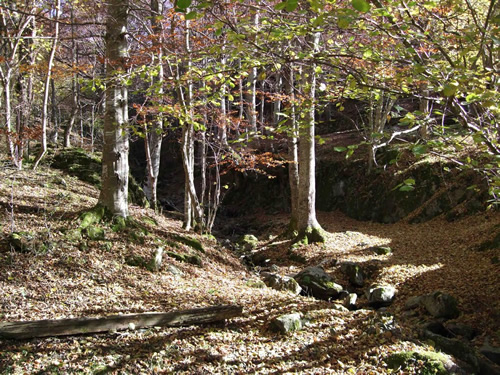
|
|
Enchanted forest on the way to San Millan's sacred cave.
|
Where Logroño, Haro, and Laguardia are in the north half of Rioja, San Millán de la Cogolla, in the Rioja Alta wine growing area, is south and away from the Ebro River. The town is named after San Millán, a local boy born in AD 473 in the Riojan village of Berceo, near the current town of San Millán de Cogolla. He studied under the hermit San Felices in Haro. He died in AD 574, and it is said he is interred in his cave in the Monasterio de Suso, which sits on the hill overlooking the village of San Millán. In truth, people aren't sure where his remains are, but it doesn't matter as his tomb in the cave possesses enough mana for all.
San Millán's cult was quite strong in Navarra and Castile, and he was often depicted in ways similar to St. James, whose pilgrimage road, the Camino de Santiago, passed just north of here. As a hermit, San Millán lived in a cave deep in the Cárdenas river valley. His miracles spread, attracting followers and fellow hermits who settled in neighboring caves. Periodically, they would meet to pray together, and their meeting place became the site of the Monasterio de Suso. Eventually, Suso became a community, thus replacing the isolated hermetic ideal with a communal monastic one. As numbers grew, the Suso monastery, perched on a hillside, could no longer house all the brothers. They moved their residence downhill in the sixteenth century to the new Monasterio de Yuso. Suso and Yuso mean upper and lower in archaic Castilian.
The surrounding caves and the two monasteries physically represent, in one valley, the transformation of the hermetic ideal to one of a community of brothers dedicated to the community and to God.
This legacy and the natural setting of river valleys, mountains, and nearby wineries make for an enchanting Riojan culinary tour. I recommend staying in the village (an excellent lodging recommendation is below), and then, to truly experience the authentic mystical nature of San Millán, take a hike by following the trail to La Cueva del Santo, San Millán's remote cave. Follow the sign to Lugar del Rio and then follow the signpost "Cueva Santa del Santo" with a drawing of a hermit with his staff. These signposts begin at the base of a driveway that leads up to a terrific rural restaurant on the right. The road to its left goes to the cave several kilometers away. The trail mostly follows the little rural road until it nears the mountain of the cave. There, it can be climbed only on foot. It leads to one of the original caves deep in the valley where San Millán lived and meditated. You can drive partway and park at the large lower corral or continue on to a parking and picnic spot at the smaller upper corral, which is at the point where the footpath begins to the cave.
On this path to the saint's cave, you will enter the mythic realm of San Millán's life. The forest is filled with sacred trees, including the Tree of Desires. Its trunk is split open in the middle, and people place stones there with their wishes and hopes as they walk by.
When you return toward San Millán de Cogolla, have lunch at the little restaurant up the driveway near where you first found the signpost for this sacred trail. It is connected to a lovely hilltop B&B and run by a husband and wife whose skill with food, wine, and hospitality equals the saints with miracles. If you walk the whole way from San Millán de la Cogolla to El Cuevo del Santo, a reasonable distance on foot, get an early start, around 7:30 or 8 AM, so you can return to the restaurant for a late lunch. Be sure to take water and perhaps a piece of fruit and some nuts.
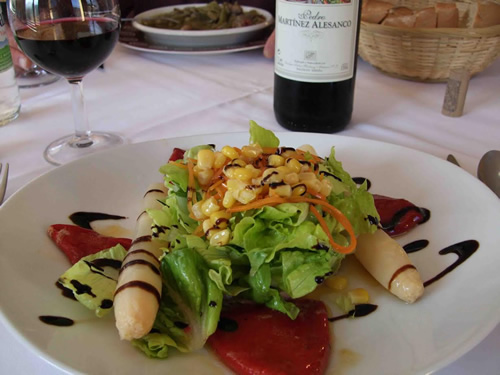
|
|
Lunch, first course, in San Millan in Rioja.
|
|
Resources for a Trip to Rioja
More than in any region in Spain, Rioja has more people who speak French and English. This might reflect the connection to winemaking, France, and the wider international world of wine collecting. In the tourist offices, be sure to ask about English tours. Some also have a published listing of bodegas that give tours in English.
Logroño:
The region’s tourist office can be visited at La Rioja Turismo. You can ask about, reserve, and purchase tickets for thematic regional wine tours and other activities.
Laguardia
The Laguardia tourism site is your central stop for information and for arranging a guided tour (the only kind) of the Gothic church of Santa Maria de los Reyes. You can also get a listing of all the bodegas open to the public for wine tours and tastings. The physical office has an excellent three-dimensional geographical model of the town and outlying areas.
Food and Lodging: Castilla el Collado (on Paseo el Collado I) is a lovely hotel and restaurant in the heart of Laguardia. The chapel in this 1920s castle is older, dating to the 18th century. You can enjoy good Riojan-inspired dishes and wine in the restaurant.
Bodegas in and around Laguardia: Laguardia has over 16 bodegas open to tours and tastings. Many require an advance phone reservation, while others are fine with a spontaneous walk-in. Outside the medieval walls are several excellent bodegas. The North American visitor will most likely immediately recognize Marques de Riscal and Palacio. These and many others are worth a visit. Again, get the list from the tourist office, where they can tailor your visit with advice on where and how to visit. Many of these bodegas have websites, including:
Bodegas Marques de Riscal
Bodegas Orube
Entreviñas y Olivos
Bodegas Ysio
Lodging, Wine and Dining in San Millán de la Cogolla:
In Badarán is the Bodegas David Moreno where several award-winning Riojan wines are made, including monastic wines, Vino del Monasterios de Yuso. They have a tasting room in the front of the winery selling the bodega's vintages. You can also email or call ahead to schedule a tour or take a chance and show up during their tour hours. Tours include wine tasting.
|
Beebe Bahrami is a freelance writer and cultural anthropologist specializing
in travel, food and wine, and cross-cultural writing.
|
